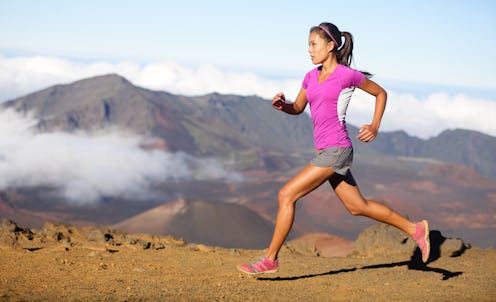
Now that spring has finally sprung, it's time to throw on your best gear, lace up your kicks and hit the ground running. And, whether you're just trying to break the monotony of working out inside or training for your first race, there's always room to improve your technique. Because the faster you run, the sooner you can indulge in delicious, refueling carbs, right?
Before you start pounding the pavement, check out what we learned from Ben LeVesconte, a running technique specialist and skillful movement coach. His tips are practically guaranteed to make you faster, so you can PR at that 5K or just look more legit on the running path.
Memorize this mantra
Here are the magic words: "Posture, rhythm, relax," says LeVesconte. "With each step, this will remind you of everything you're going to read below, and will increase your performance and lessen your chance of injury." For more on why this mantra works, check out this e-book.
Work on your posture
Here's the thing: "Gravity is the greatest natural force on earth, so you can't break it — you can only break yourself upon it," says LeVesconte. Translation: Gravity pulls you down to earth, slowing you down. "To become faster, you need to be segmentally aligned. That means your ears, shoulders and hips are in vertical alignment. You can minimize the effects of gravity by standing tall. The crown of your head should be the highest point of your body. Do not lean forward, avoid twisting the upper body, and keep your arms close to your body."
Get a rhythm going
"A quick rhythm is crucial for metabolic conditioning and maximizing elastic recoil — free energy," explains LeVesconte. The sweet spot: around 180 beats per minute. To practice, buy a metronome app — "The Steinway piano app has one built into it and is super easy to use" he suggests — and run with it until you are well accustomed to the rhythm. "You should always land on the balls of your feet and be sure your heels make good contact with the ground," he adds. "Think lift on the beep, not land. The lighter your foot contact with the ground, the more your foot and ankles are absorbing force and the less impact is going into your shins, knees, hips, and upper body."
Relaaax
It's hard to imagine being tense while running, but when you're pushing yourself, it can happen. "Tension causes more injuries, uses more muscle action, and slows you down," says LeVesconte. "Try tensing your neck, shoulders, arms, hands, back, stomach, glutes, legs, ankles and feet for 10 to 20 seconds and then let them relax to remind you what relaxation feels like."
Add flexibility and strength training
Running alone won't make you faster — you need to push yourself in other fitness areas as well, from micro drill exercises to squats and abdominal work. "Perform simple toe exercises such as pinning your big toe in the ground and lifting the others up while standing during the day reengages communication with feet and improves balance," suggests LeVesconte. "Squats are crucial to improve ankle flexibility, and ankle flexibility is crucial to stay injury free when adding distance and speed. Planks build abdominal strength which helps maintain segmental alignment when running." It's a system — you can't get better at running if you don't work the others.
Remember: form follows function
If you want to get faster, you might need to slow down first. "Skillful technique shapes the human body form," says LeVesconte. So, take a minute and make sure you're doing it right before you up your speed. "Running is a pulling action with the hamstrings, so as you add speed, kick your heels towards your butt to keep your legs as close to your center line as possible, and avoid trailing your legs to avoid hamstring pulls and maximize elastic recoil," he adds. "Posture, rhythm, relax!"
Image: Maridav/Fotolia